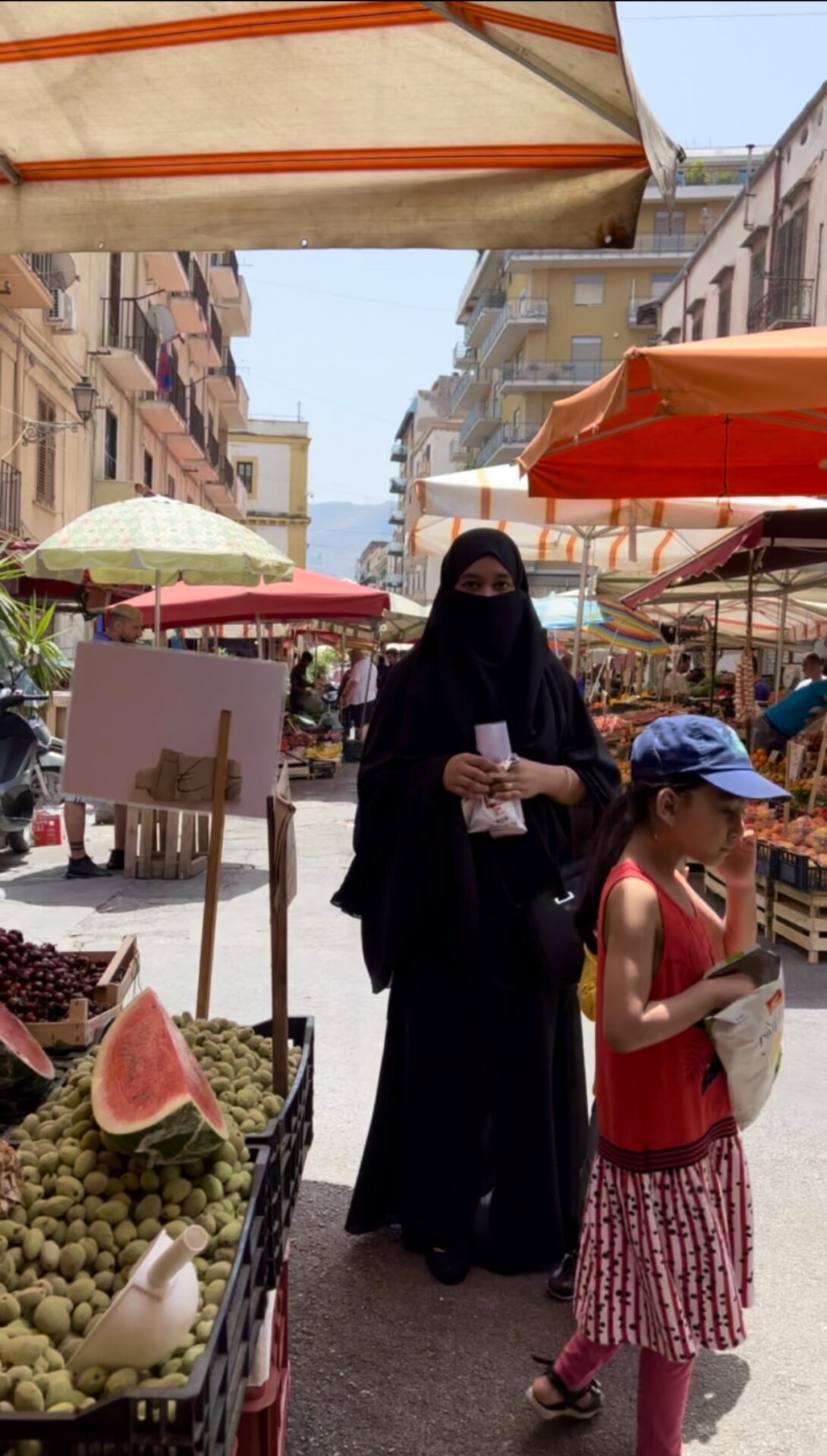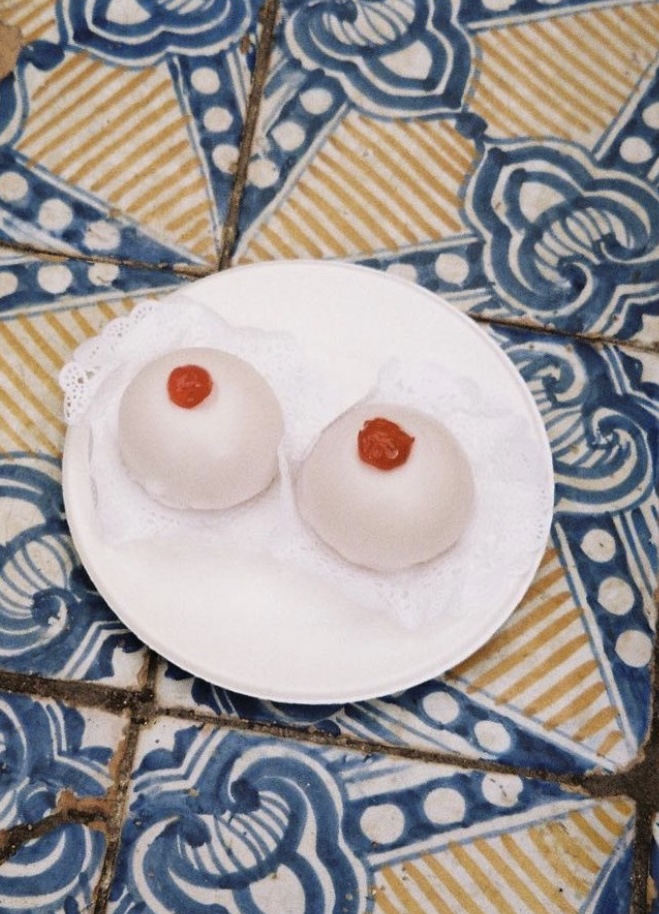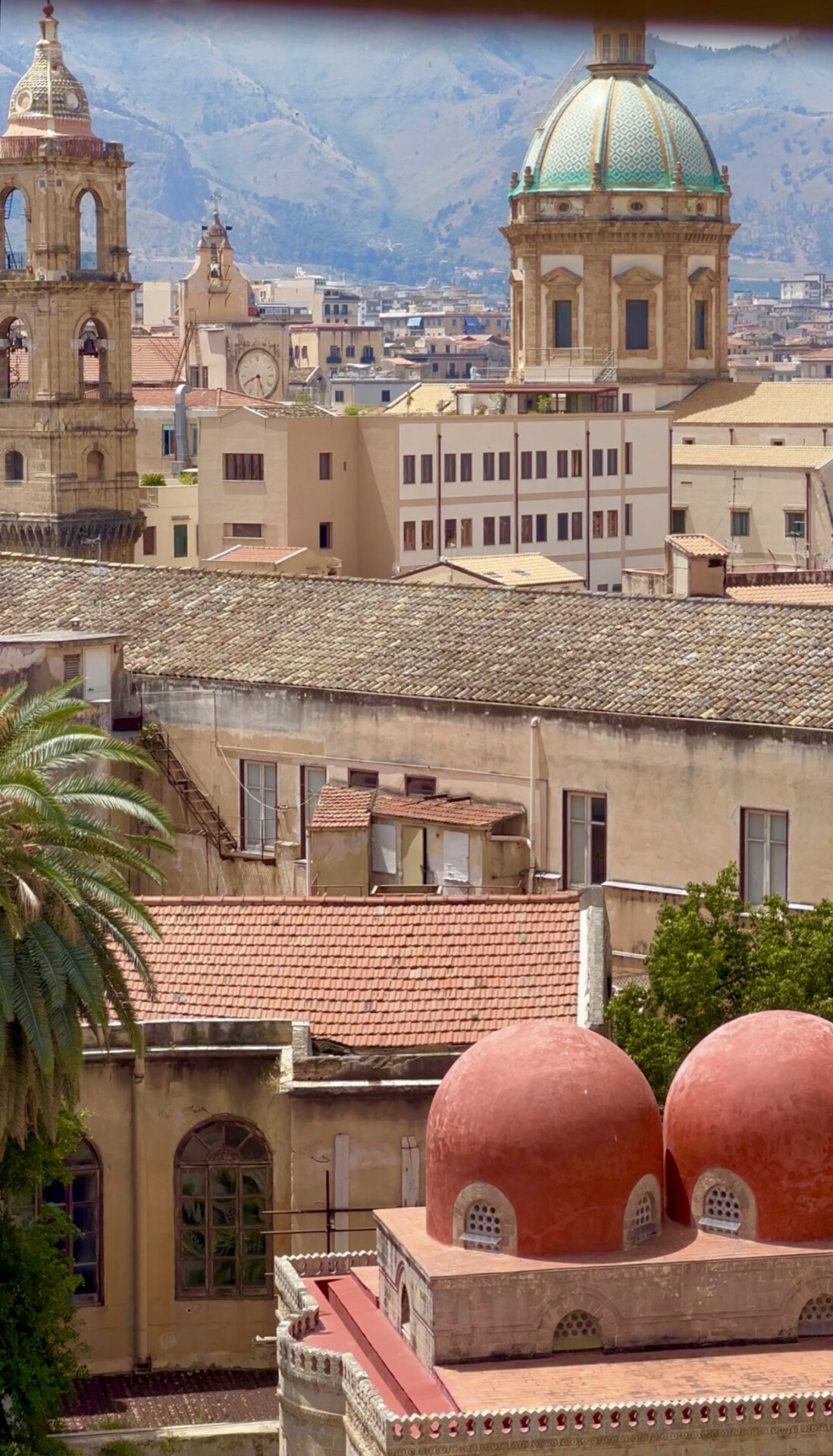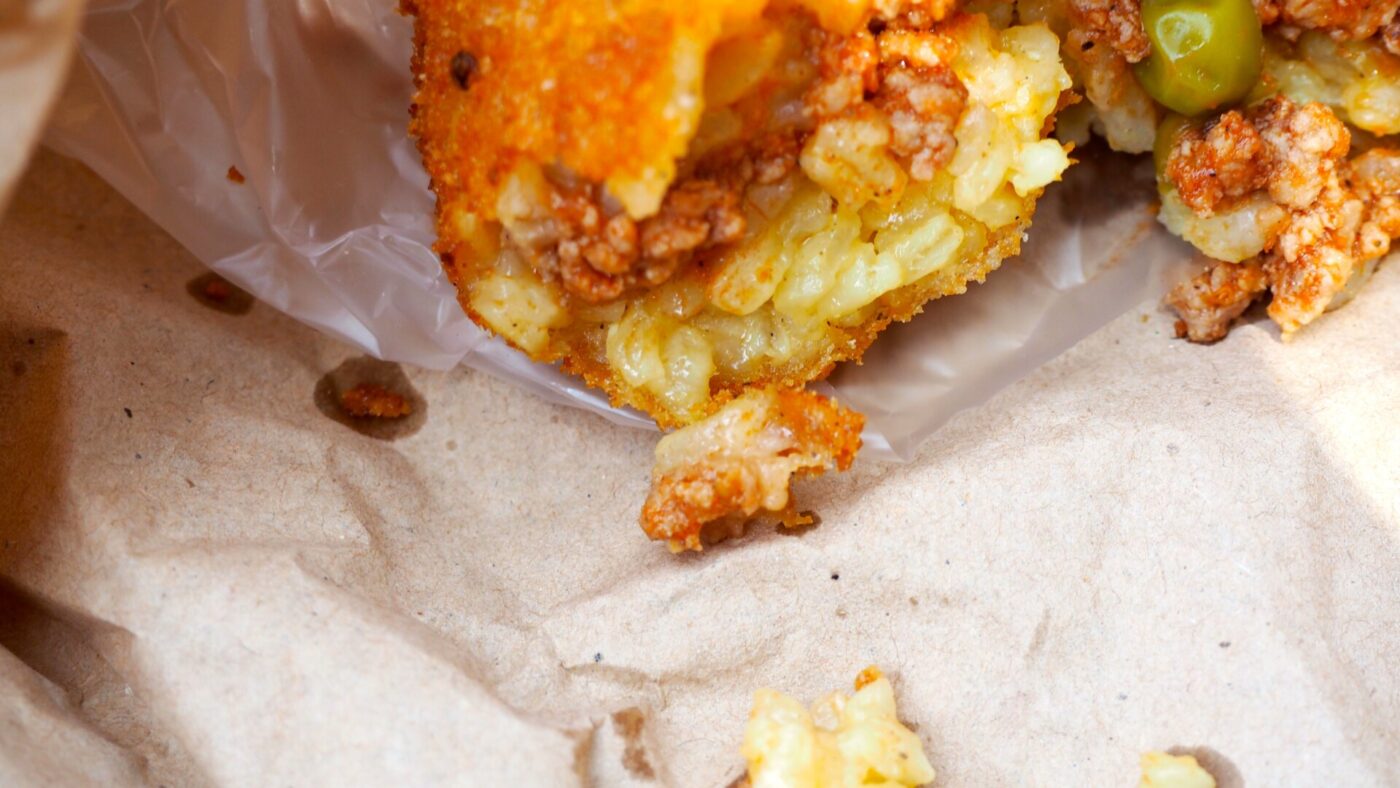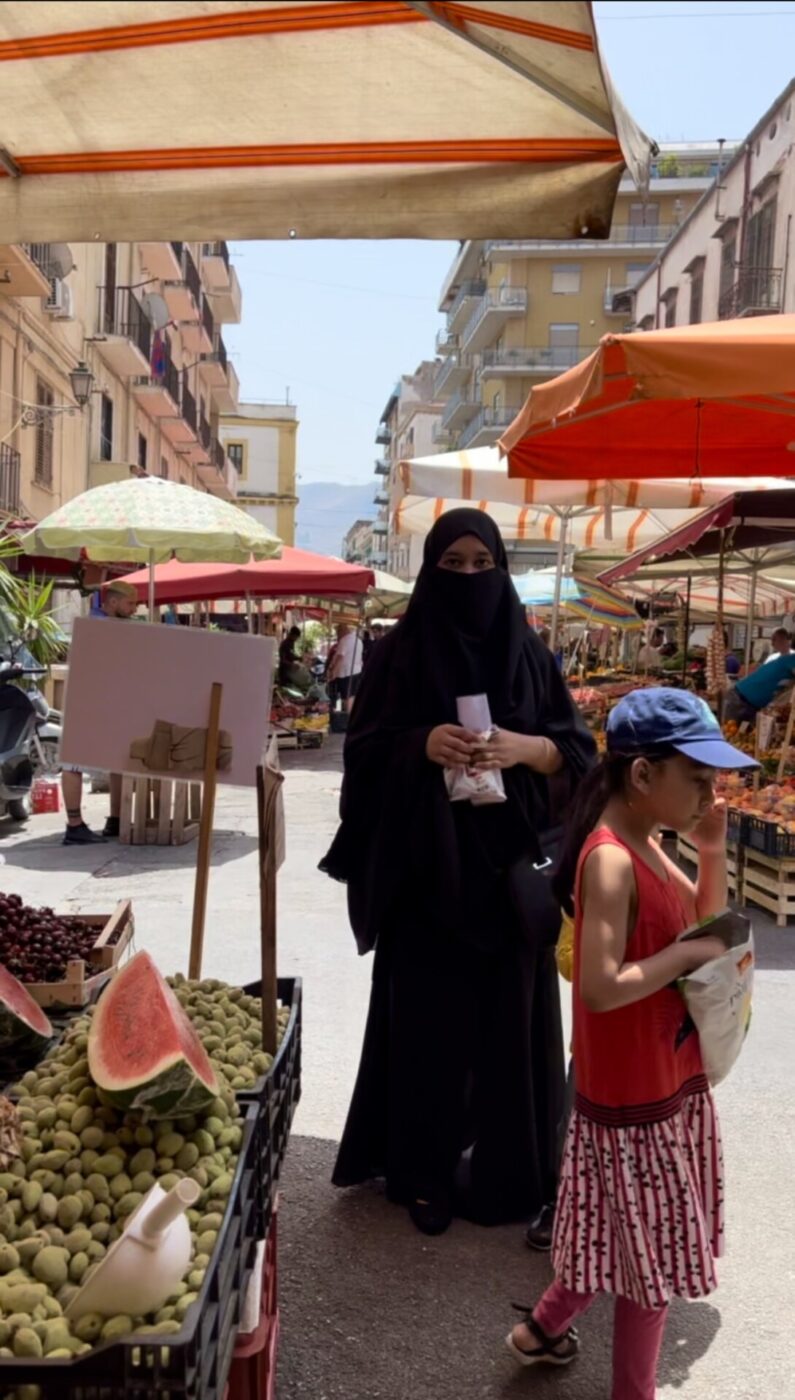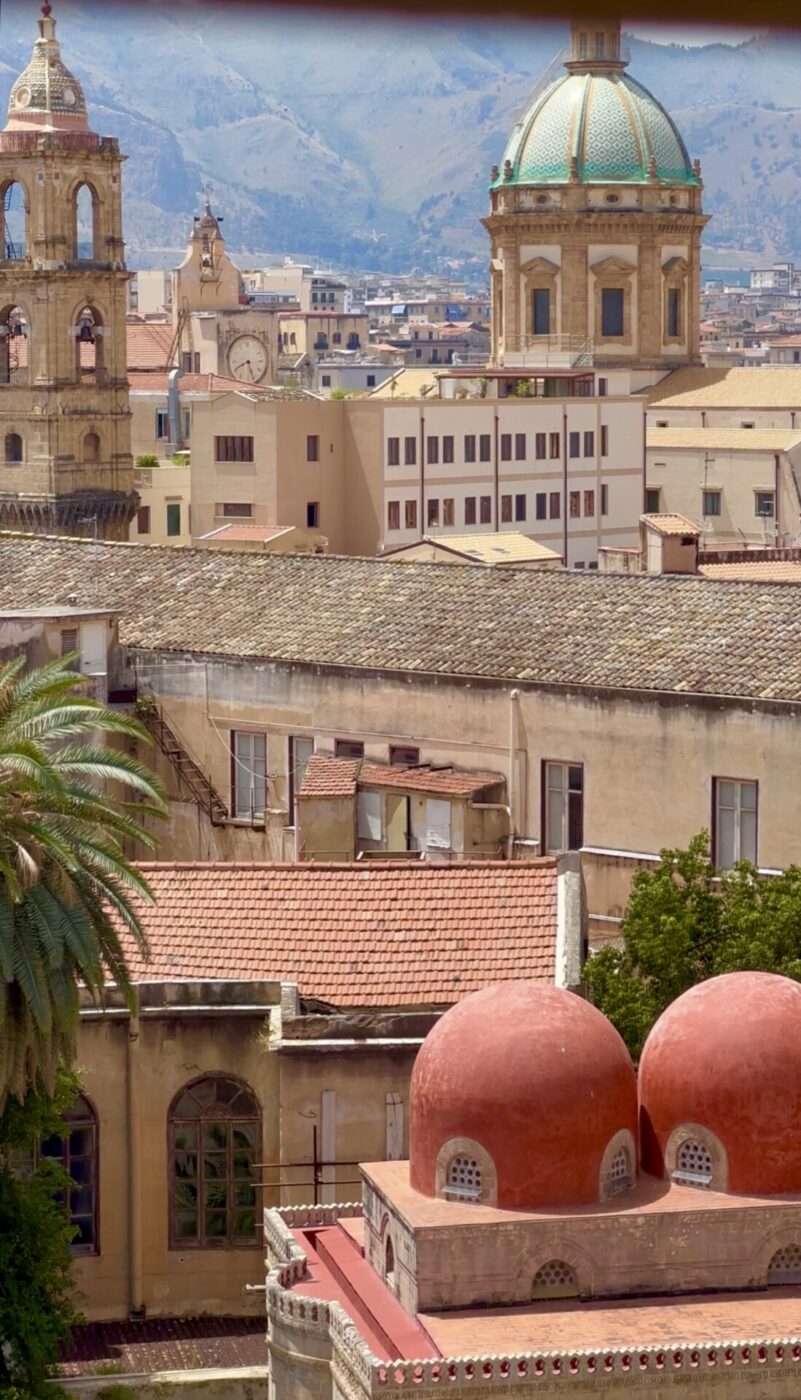Less than two miles off the coast of the Italian mainland, Sicily is the largest and most celebrated island in the Mediterranean. We all think we know Sicily. Its romanticized landscape, its exotic culture, that it’s Italy… but at the same time it’s not. The Sicily of my grandparents’ folklore, of The Godfather, and even more recently, The White Lotus, is exaggerated but is in part true. It is breathtakingly beautiful. It is indeed a complex place, with a sweet and sour volatile past that could be best described as agrodolce. But to truly know Sicily and its people is to understand its Arab identity.

San Cataldo, Palermo
Sicily is a constant geographical and cultural entanglement between Italy and the Maghreb–one founded by a mixture of Mediterranean peoples such as the Phoenicians (Modern Day Lebanese), Carthaginians, Greeks, and the native Sicels. This land and its people have endured centuries of subsequent invasions and occupations from the Romans, Arabs, Spanish, French, and Normans. This has led to a blended identity that is hidden in its architecture, lived by its people, and most importantly, consumed in its food.
I took the ferry across the Strait of Messina in search of the enchanted Sicily that many historical Arab writers praised as the “noblest, most prolific garden in the sea.” A Sicily that at the time was the center of the world. Exemplary in all facets of life, this floating “Garden of Eden” was praised for its vast, fertile fields of date palms, sugarcane, cotton, pistachios, and citrus.
While on the ferry, I already started to see and hear traces of the omnipresent Arab influence here. A couple in their thirties sat watching the sea birds dance and eating something I was all too familiar with: arancini. The easiest, most delicious transportable snack brought by the Arabs in the 10th century, with their introduction of saffron and rice.
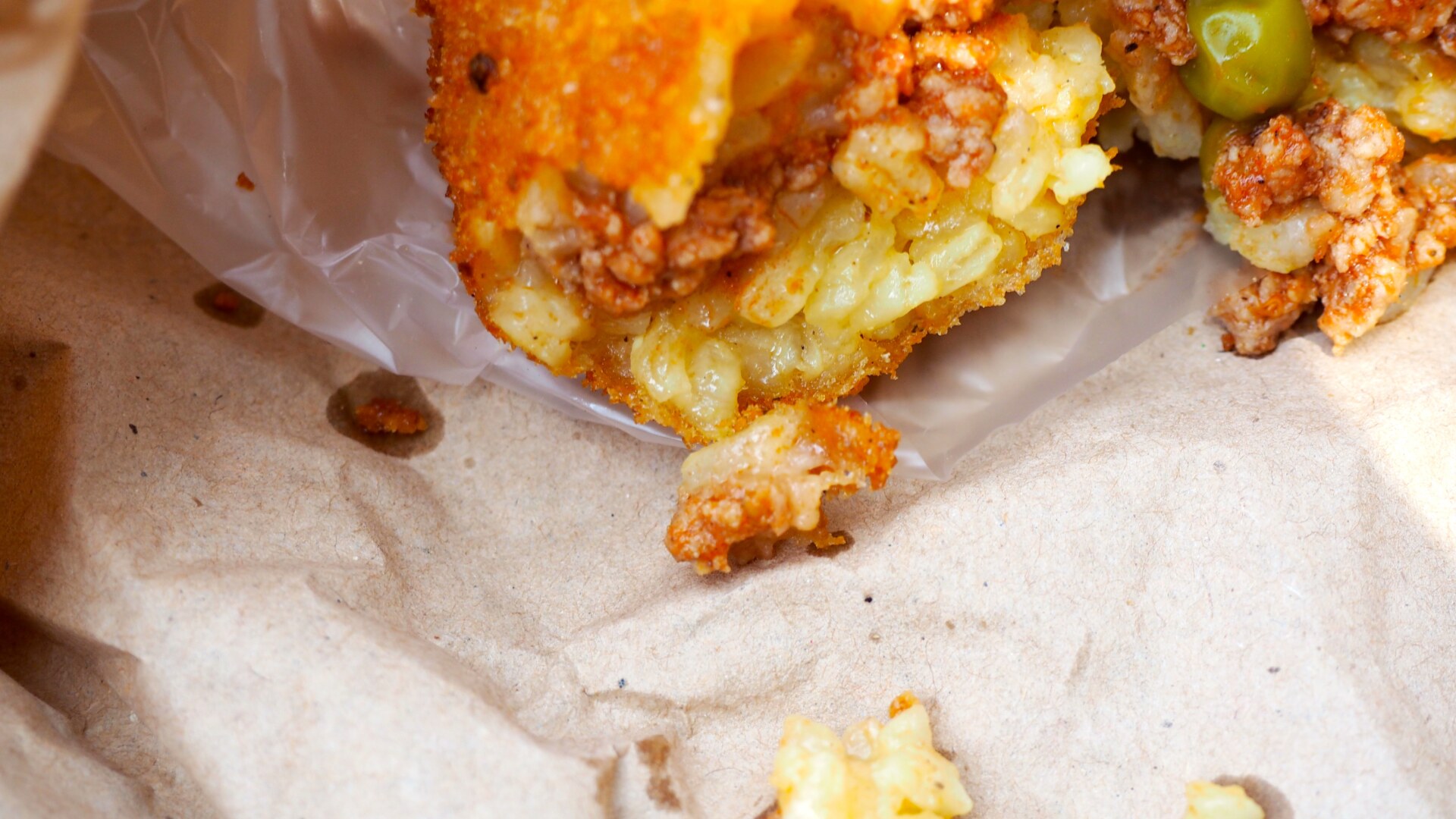
Arancini
As I walked to the bow to get a better look at Messina and the approaching golden Madonnina statue, I overheard an elderly woman greet another woman with the proverbial Sicilian acknowledgement of sabbinirica, an expression meaning “May God bless you” coming from the Arabic “Salaam Alaikum”. As a Calabrian and a linguistic nerd (our dialect being half Sicilian, half Neapolitan), this expression utterly fascinated me. Its subtleness and melodic tone can easily be overlooked as a simple “hello”, but its meaning is arguably one of the most important daily reminders not only of the linguistic cultural legacy that the Arabs left over a millenia ago, but also their impact on the overall ethos and psyche of Sicilians.
My first stop would be the picturesque seaside resort town of Cefalú, in the Arab heartland of the island. After a two-hour drive via the Messina-Palermo autostrada–weaving through mountainous tunnels and passing towns with Arab derived names such as Alcara li Fusi, Tusa, and La Kalura–I arrived.
It’s easy to become enamored with the beauty of Cefalú. As you take the exit off the autostrada, you start to see the top of the gigantic Rocca di Cefalú mountain peaking out in the distance. This once highly inaccessible town was settled in the shadow of the mountain. Walking along the lungomare, you have the bay to your left and the city center immediately in front of you. The white caps from the waves crashing in the distance seem to make this sun drenched picturesque Mediterranean seaside town feel like an installation at Art Basel. My eyes were in sensory overload: the azure water, the mosaic of whitewashed buildings reminiscent of Tunis…but the one thing that held my gaze was the large, minaret-looking towers of Cefalú’s infamous cathedral, dominating the skyline.
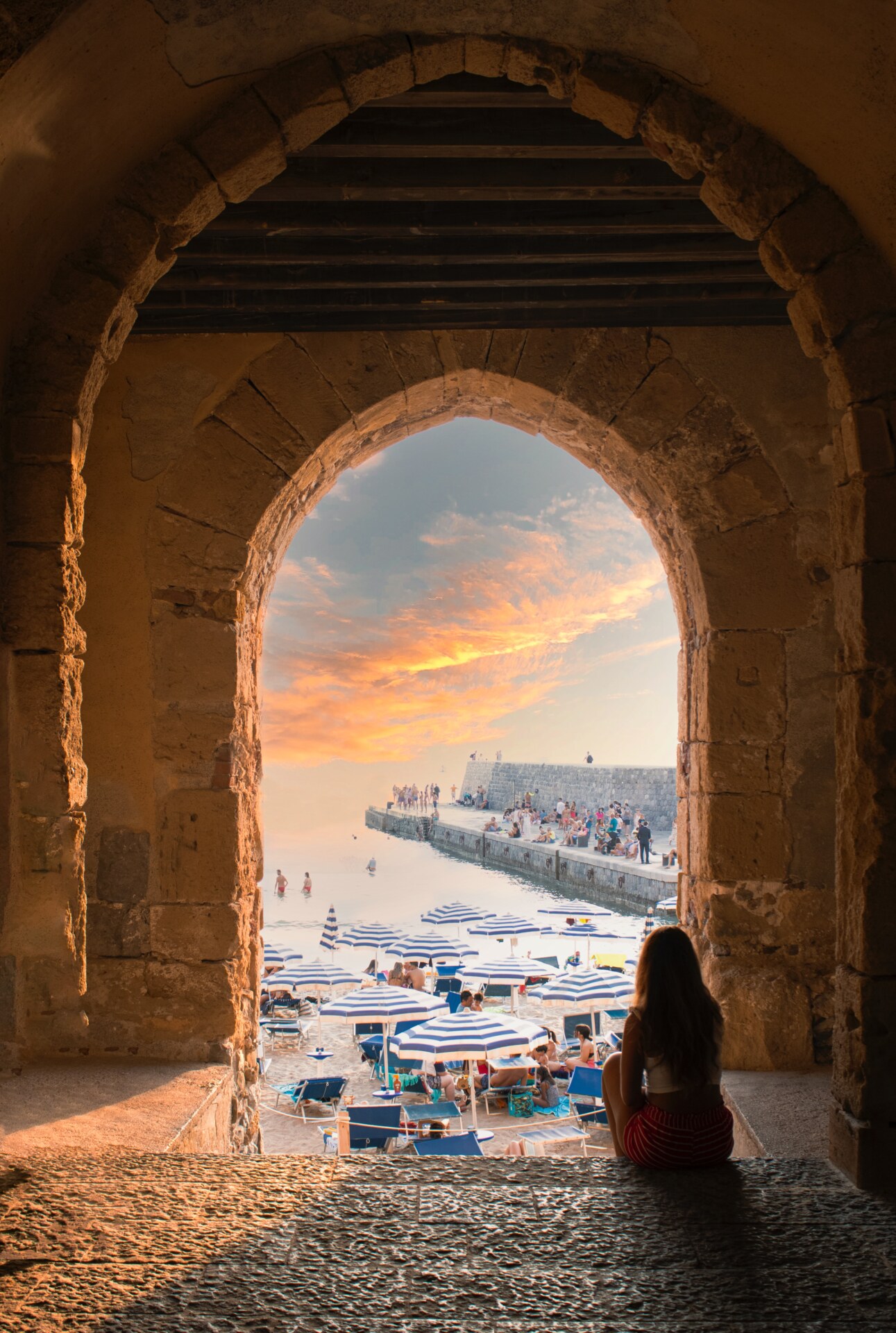
Cefalù, Sicily
Simplistic but striking, this fortress-like building is a prime example of Arab-Norman architecture, a style marked by its occidental features, columns, and calligraphy that flourished after the Normans had conquered the island in the 1100s, which saw a new hybrid culture appear–one in which the invaders recognized the beauty and efficiency of the prior establishment and, rather than exterminating the previous culture, blended the Arab, Greek, and now newly Scandinavian traditions into one. This cathedral was constructed under the patronage of Norman King Roger II and was designed to reflect the grandeur of Byzantine architecture, merging elements of Eastern and Western aesthetics.
As I advanced towards the sandstone behemoth, I couldn’t help but be a bit intimidated. It is perched smack dab in the middle of the town, staring directly into the Mediterranean sea. Its outside appearance looks militaristic, but as I wandered inside, I found it to be littered with intricate golden mosaics that I recognized to be more Eastern Christian than anything else. These mosaics date back to the 12th century: the most captivating is the apse mosaic, featuring a shimmering Christ Pantocrator and single figures from the Old Testament below, a rare form without scenic depictions.
Like any Sicilian town, there is an outdoor market every Saturday in Cefalú. Luckily in season, I got to try some local apricots from nearby Scilotto–otherwise known as albicocco di Scilotto. The word “albicocco” comes from the Arab word “al-burquq”.
After walking around and making a brief stop at the beach, I went to the trendy Cortile Pepe to sit in their courtyard and splurge a little, because that is what a holiday is for, after all. I finished my bottarga- and lemon–laden potato primo piatto and tried their cassata for dessert. A Sicilian speciality, cassata hails from the Arabs both by name and in ingredients–cassata coming from the Arabic word quash’at, for bowl.
It was the Arabs who wildly transformed Sicily’s agricultural practices and ultimately their ingredients. Emerging from lands where water was scarce, they were master engineers in irrigation, instilling revolutionary land practices that are still in use today.
In fact, the majority of Arabic-derived language that is still present in modern Sicilian comes from agricultural practices or food items, which goes to show the importance of how Arabs influenced this land. One can make the argument that food is the cornerstone of every culture, and that even if the Arabs and the following Arab-Norman kingdom only lasted about 400 years or so, they undeniably left the largest imprint in Sicily–after all, there would be no Sicily without its adoration for all things food.
After a day in Cefalu, it was time to head to the Sicilian capital, Palermo. The capital is an hour’s drive down the E90, stopping for a midday swim at the pristine Arco Azzurro in the coastal town of Bagheria (Phoenician/Arabic for “Windy Gateway”), before continuing on my journey.
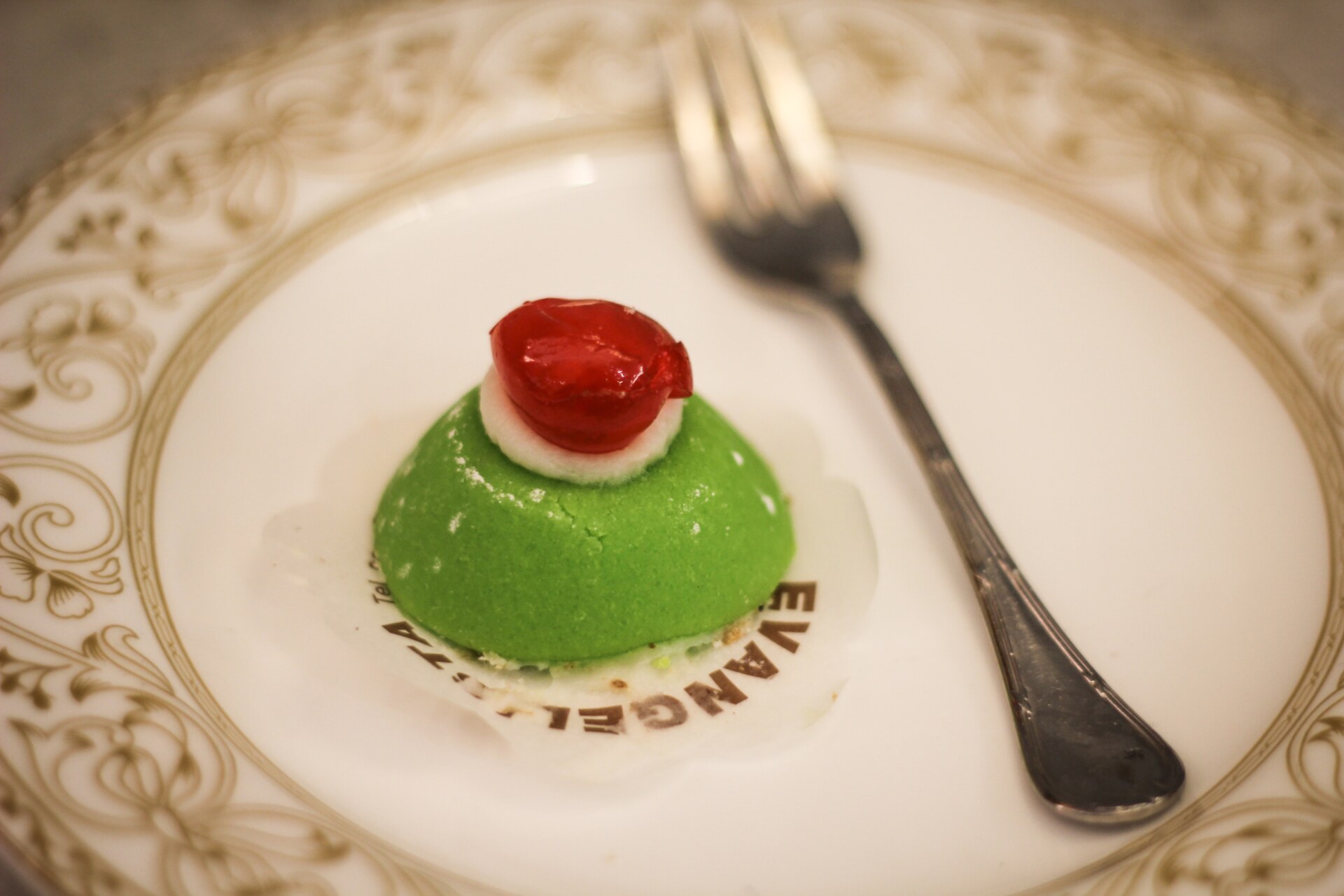
Cassata
Palermo is half living art exhibit, half souk. There’s a symbiotic beauty in the chaos here, in the quick rev of a vespa as it comes a foot away from you, the driver’s passenger clinging on for dear life, using their hand to give you a quasi “excuse me” as they jet past.
Through its palm-laden center I couldn’t help but notice the charismatic street vendor selling panelle, a fried chickpea fritter that also came via Arab domination.
I stopped for a snack and took a gander at the rugged architecture, with its intricate craftsmanship. As my eyes wandered the building, I came across a street sign written in Italian, Hebrew, and Arabic.
While it’s known that most cities in Italy have a storied, diverse past, it is Palermo that takes the title. Like everything else in this city, these signs are a constant reminder that you cannot truly tell where one culture begins or another ends. To say what is fully Sicilian–or fully Arab–in origin is to play a tug of war with one’s own head and heart.
As I continued my two-kilometer walk from Giardino Garibaldi through the alleys of Via dei Cartari, I made my way to the Ballaró market. Its name is derived from the Arabic “Suk-il-Bahlarà”, paying homage to the ancient name of nearby village of Monreale, where many of the Arab farmers came from. In operation for over 1,000 years, this ancient, open-air street bazaar continues to be the beating heart of the city.
Theatrical shouts rang aloud for “limone limone” and other products; gorgeous olives, local cheeses, Sicilian cucuzza, citrus, raisins, and pistacchio. But, it was the eggplant and the pani câ meusa that really made me stop.
I beelined to the eggplant vendor, who showed me all the varieties he had, some of which most likely wound up in somebody’s caponata later that evening. If you haven’t had caponata, it’s best described as a Siculo-Arabic remix of a French ratatouille. But, where ratatouille is a medley of vegetables, caponata stars eggplant in an agrodolce sweet and sour sauce that adds mouth-puckering complexity.

Photo by Carlotta Panza
Next, the pani câ meusa vendor. Usually made from lamb or veal, this carnivore’s delight was invented by Jewish butchers during the time of the Arab domination–and it isn’t for the lighthearted. Meaning “bread with spleen”, the street food is deep fried, given a squeeze of crisp and tangy Sicilian lemon, and sandwiched in a fresh bread roll. While I wasn’t hungover, I stood there thinking this greasy dish could probably be the answer all of us are looking for.
I ordered my panino and kept moving. After five minutes of walking–having passed the two most famous examples of Arab-Norman architecture, the Norman Palace and the Palermo Cathedral–it was time to sit and eat under the palm trees at the Villa Bonanno park.
Sitting there, I watched the palm fronds move in the gentle wind and the sun cast shadows onto the Cathedral. For the first time on my trip, I felt sincerely at ease. I had been in such a rush to see as much as I could, trying to find the complex answer I came here for, rather than taking a step back and just being.
Spacing out, I thought of how harmoniously the ambient sounds of Ballarò paired with the pani câ muesa. I went in for another bite, and, as my eyes and ears came back to reality, an elderly couple sitting across from me smiled. I hurriedly chewed and swallowed my delicious treat and, without hesitation, I looked at them with a full heart and said “sabbinirica,” finally understanding its true meaning.


